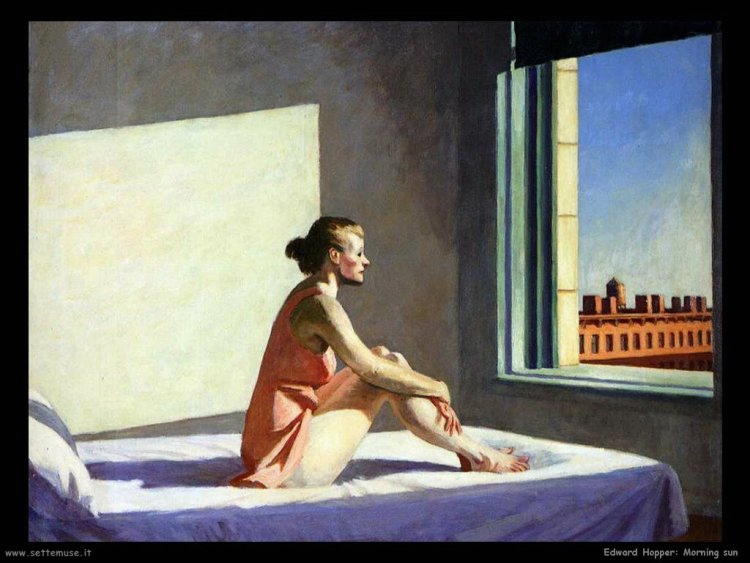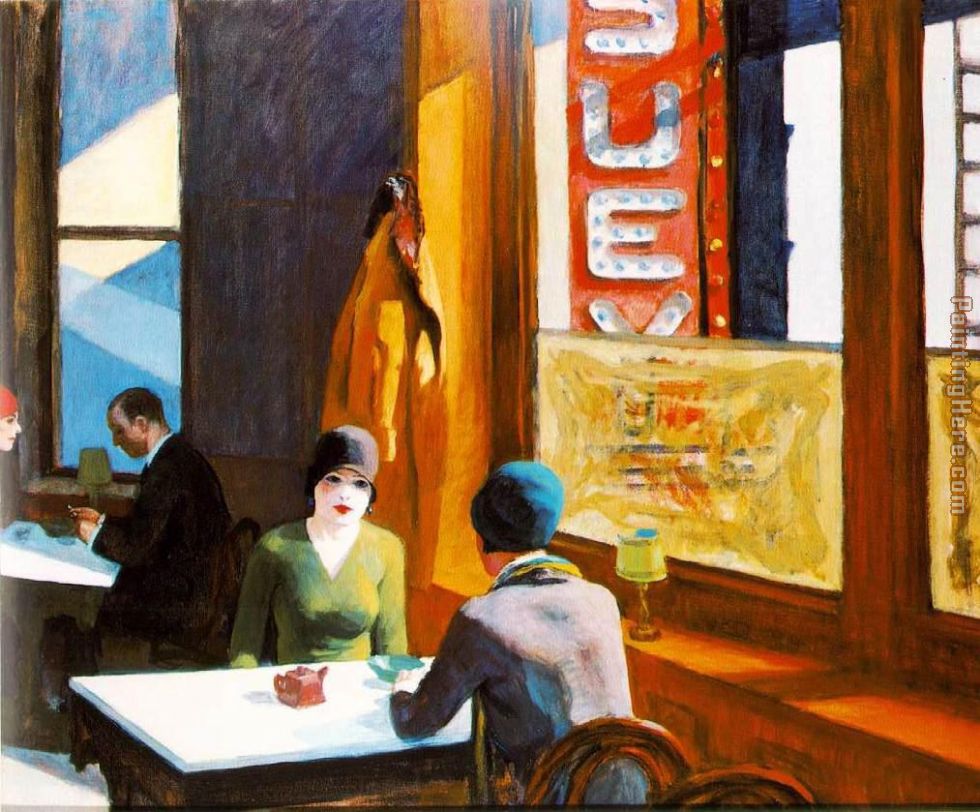
Fig 1. Morning Sun
Hopper's work is always suggested as framed but it isn't always the framing of just one specific focus, there sometimes feels as though there is a split in the framing which draws the viewer's eyes from one focus to the other. This seems to suggest Hopper's idea of the world of the main subject not being the only world, this is especially evident in paintings where windows feature. The subject looks outside aware of the existence beyond their own whereas, the viewer can only see the subject and a fragment beyond the window. Hopper shows alienation of this figure but also of what the viewer knows of this painting yet there is some sort of hopefulness about these scenes where the figure seems to be reaching out to this existence.

Fig 2. Nighthawks (1942)
There is an ambiguous sense about his paintings in that the viewer is left to try and figure out what is happening. There is no clear ideology or meaning behind the scenes, the viewer creates their own story. Take Nighthawks for example, the male and female beside each other could be having an affair and the man alone for all we know could have been paid to keep watch on them or even have nothing to do with them, rather having a secret that he needs to tell the barman.

Fig 3. Chop Suey (1929)
With some of Hopper's paintings his figures feel doll like or like mannequins where they have been positioned in such ways that Hopper felt suitable. It is not just their pose but their faces that feel emotionless and make them feel even more like an object of these scenes rather than important figures that tell a story. They are used rather to allow the viewer to convey their own perception of the paintings. You could even view these paintings as if Hopper had a dolls house and had arranged his props in such a way then used the environment as a basic of his painting. If you were to carry on the lines of these paintings such as Chop Suey it could reveal just that.

Fig 4. Second Story Sunlight (1960)
What is uncanny about Hopper's work is the voyeuristic pleasure the viewer is allowed into the painted figures lives. There is a simplistic view on life and as Gregory Crewdson puts it 'It’s amazing how many of Hopper’s pictures feature something as simple as a bed, windows, or doorways. I think this serves to emphasise further the viewer looking with a kind of voyeuristic gaze into the world.' (Crewdson, 2004) The viewer feels as if they shouldn't be watching what they are seeing and feel guilty peering into these worlds but this doesn't stop them continuing to gaze if anything it makes them want to look more because they want to know what is actually happening through these ambiguous scenes. These scenes feel like they could be real representations of life and this just allows the viewer to give these characters sad stories. Hopper's positioning of his characters and objects within the scenes makes them look as though they are meant to be viewed but because we see beyond this into a representation of reality this feels uncanny to us. Weird to look into someone's private life so freely.
What is uncanny about Hopper's work is the voyeuristic pleasure the viewer is allowed into the painted figures lives. There is a simplistic view on life and as Gregory Crewdson puts it 'It’s amazing how many of Hopper’s pictures feature something as simple as a bed, windows, or doorways. I think this serves to emphasise further the viewer looking with a kind of voyeuristic gaze into the world.' (Crewdson, 2004) The viewer feels as if they shouldn't be watching what they are seeing and feel guilty peering into these worlds but this doesn't stop them continuing to gaze if anything it makes them want to look more because they want to know what is actually happening through these ambiguous scenes. These scenes feel like they could be real representations of life and this just allows the viewer to give these characters sad stories. Hopper's positioning of his characters and objects within the scenes makes them look as though they are meant to be viewed but because we see beyond this into a representation of reality this feels uncanny to us. Weird to look into someone's private life so freely.

Fig 5.
Bibliography
Crewdson, G. (2004) Aesthetics of Alienation http://www.tate.org.uk/tateetc/issue1/article10.htm (Accessed 07/12/2011)
Illustrations List
Figures 1-5. Hopper, Edward [Oil on canvas] Settemuse http://www.settemuse.it/pittori_scultori_americani/edward_hopper.htm (Accessed 07/12/2011)

1 comment:
:D
Post a Comment